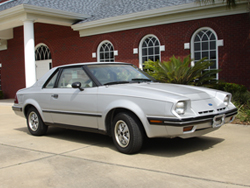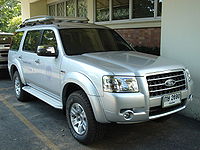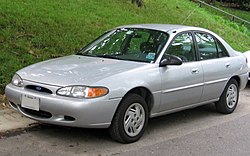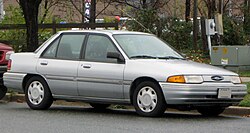Ford EXP
 | |
| Manufacturer | Ford Motor Company |
|---|---|
| Production | 1982–1988 |
| Assembly | St. Thomas Assembly, Ontario,Canada Wayne, Michigan, United States |
| Successor | Ford Probe |
| Class | Sport compact |
| Body style | 3-door hatchback |
| Layout | FF layout |
| Platform | Ford CE14 platform |
| Related | Ford Escort Ford Tempo Mercury LN7 Mercury Lynx Mercury Topaz |
The Ford EXP and Mercury LN7 were the first two-seaters that Ford offered in 25 years. The coupes shared the wheelbase and mechanicals of the Ford Escort with a longer, more stylish body. It was first shown at the Chicago Auto Show and introduced in April 1981 as an early 1982 model.
Comparing the EXP to the original Thunderbird, Ford Division General Manager Louis E. Latalf said: "We're introducing another two-seater with the same flair, but the EXP will be a very affordable, very fuel efficient car matched to the lifestyles of the eighties."
As the 1980s began, Ford was in a transitional phase. Henry Ford II retired as chairman, Lee Iaccoca was at Chrysler, and chief stylist Eugene Bordinat had also stepped down. Ford's marketing strategy at the time was based on their perception of American society in the early 1980s. Ford felt that the growing number of one and two person households, combined with the lifestyle of the younger target audience who desired a small sporty car, led them to the conclusion that Americans wanted a "lively little car that is dependable, efficient, and good-looking".
Ford's marketing department believed that if a customer wanted room for four or five passengers, they would buy an Escort or a Fairmont. The marketing philosophy for the EXP's seating was rather like that of a European gran turismo; a personal vehicle for two, with a cargo area in back for emergency transport of anything or anyone else. While it was moderately successful in sales for a two seater, it not only lacked performance but its styling still described as "a sound beating with the ugly stick ... unbelievably awkward, oddly proportioned lines and a curious headlight treatment".Although the EXP still has its fans, it never gained the cult following of cars such as the Pontiac Fiero, Toyota MR2, and Honda CRX which were built and styled around their own unique platforms. It ultimately would be dropped in favor of the 2+2 Ford Probe.
Name origin
For a long time, some were adamant that the letters stood for "EXPerimental"; others said that Ford marketing executives just thought it was an interesting combination of letters that did not have a meaning. However, according to an article published in Popular Mechanics(March 1981), the letters EXP were supposed to stand for Erika Project Personal car, where project cars are designated X. The "Erika" came from the code-name from the European Escort.
First generation (1982–1985)
 | |
| Production | 1982–1985 |
|---|---|
| Engine | 1.6 L CVH I4 |
| Transmission | 4-speed IB4 manual 5-speed MTX-III manual 3-speed FLC automatic |
| Wheelbase | 94.2 in (2,393 mm) |
| Length | 170.3 in (4,326 mm) |
| Width | 65.9 in (1,674 mm) |
| Height | 50.5 in (1,283 mm) |
| Curb weight | 2,047 lb (929 kg) |
There had been a push by automobile manufacturers around the world to make small, fuel efficient cars. This was precipitated by the OPEC oil embargo of October 17, 1973–1974. This embargo included a 70% increase in oil prices, causing long lines at gasoline filling stations, and skyrocketing prices for gasoline. People wanted, demanded more miles for their gasoline dollars. Ultimately this led Detroit, Tokyo and Germany to rethink the adage that "bigger is better".
The world would respond with smaller cars. A second energy crisis and a renewed recession followed in 1979-1982. Ford studied a two seater commuter car called the Super Gnat. It was to have a three-cylinder engine with a wheelbase of just 78 inches. Ford also produced as a concept the Mustang RSX, which was a slightly smaller two-seat derivative of the Mustang.
Lee Iacocca leadership at Ford had previously introduced one of its most successful cars, the Mustang. The Mustang [1964 ½] originally was no more than a Falcon with a different, more sports-car like body. Similarly, Ford would adapt their newest economy cars, the Ford Escort and Mercury Lynx by putting a sporty body on top and removing the rear seats to produce the EXP and LN7.
The EXP's rakish non-boxy body rode on the Escort's 94.2 inch (2393 mm) wheelbase, with that car's front-wheel drive running gear, four-wheel independent suspension, and dashboard. The EXP was longer, lower, and sportier than the Escort.
Performance wasn't the car's strong suit however, since the EXP weighed about 200 pounds more than Escort but carried the same small 1.6 L CVH I4 engine rated at 70 hp (52 kW) and a standard 4-speed IB4 manual transaxle. Nevertheless, the March 1981 issue of Car and Driver reported that their EXP with a manual transmission reached 44 MPG on the highway, a figure comparable to modern hybrid cars.
Both the Ford EXP and the Mercury LN7 had a sharply sloped windshield, wheel arches with prominent lips, and wide body side moldings not far below the top of the wheel well. The biggest difference was the rear fascia.
The EXP was a notchback with a lift-up hatch, while the LN7 used a big "bubbleback" back window. The EXP's minimalist grille consisted merely of twin horizontal slats on the sloped front panel (the LN7 had ten).
Priced considerably higher than the Escort, the EXP carried an ample list of standard equipment. It included power brakes, full instrumentation, full carpeting, electric back window defroster, power hatchback release, a digital clock, and a cargo area security shade. Models with a manual transmission had a sport-tuned exhaust. Automatic models had a wide-open throttle cutout switch for the optional air conditioning compressor clutch.
As the full 1982 model year began, Ford offered an optional (at no extra cost) 4.05:1 final drive for better performance. Later came a close-ratio transmission with 3.59:1 final drive ratio intended for the same purpose.
Finally, in March 1982, an 80 hp (59 kW) version of the CVH engine became available. It had higher (9.0:1) compression, a larger air cleaner intake, lower-restriction exhaust, a dual-outlet exhaust manifold, larger carburetor venturis, and a higher-lift camshaft.
The LN7 did not last long. A sporty two-seater seemed out of place in Lincoln-Mercury showrooms, and it was dropped in 1983 after only a total of 40,000 were sold.
EXP Turbo Coupe
By 1984, Ford was trying hard to conquer the youth market, especially the affluent young motorist with offerings such as the Mustang SVO, Thunderbird Turbo Coupe, and the new EXP Turbo Coupe.
The turbocharged 1.6 L CVH engine, available for the Escort and EXP, featured a high-lift camshaft and EEC-IV electronic controls. It delivered boost up to 8 psi, raising power to 120 hp (89 kW), a gain of some 35 percent over the naturally aspirated models.
The Turbo Coupe had a unique front air dam and rear decklid spoiler, with a taped "Turbo" badge on the rear bumper. It also had two-tone paint with a black lower section, a unique C-pillar appliqué featuring the EXP lettering, black wheel flares, and black rocker panel moldings.
Return of the EXP
By the mid-1980s, two-seaters were in vogue. Cars such as the Pontiac Fiero and Toyota MR2 (both mid-engined, rear-wheel drive sports cars) were so popular that even Cadillac was considering producing one.Yet despite their popularity, Ford EXP sales were sluggish. Its styling was stale, and for a sports car, its performance was generally regarded as less than adequate. Build quality and refinement were also inferior to Japanese competitors such as the MR2 and Honda CRX.
The employees, with a bit of assistance from the plant manager, went down to the body shop and pirated parts from the other models and put together what they thought was a much better-looking EXP. Peters, Tom. Thriving On Chaos: Handbook For A Management Revolution.
The result was the 1985½ Escort EXP, and after a brief absence from the lineup after the end of the 1985 model year, the EXP returned with a new look and a re-badged nameplate. During its first three months it posted steadily increasing sales, but even the new styling and upgraded power plant wasn't enough to save the EXP.
Second generation (1985½–1988½)
 | |
| Also called | Ford Escort EXP |
|---|---|
| Production | 1985.5–1988.5 |
| Engine | 1.9 L CVH I4 |
| Transmission | 4-speed IB4 manual 5-speed MTX-III manual 3-speed FLC automatic |
| Wheelbase | 94.2 in (2,393 mm) |
| Length | 170.3 in (4,326 mm) |
| Width | 65.9 in (1,674 mm) |
| Height | 50.5 in (1,283 mm) |
| Curb weight | 2,388 lb (1,083 kg) |
A reworked Escort had appeared as a late-year 1985 model with the 1985.5 model year EXP. This 1985.5 model had a 2 barrel carb and the 1985 escort steering wheel and had a new form with a sleek new front-end design, including an air dam and flush-mounted headlamps. The new EXP also acquired the LN7's bubble hatch. Otherwise, the new four-window couple design looked similar to the original EXP at the rear, but markedly different up front.
Gone were the distinctive "frog-eye" headlights, replaced by flush-mounted headlamps with wraparound marker lenses and parking lamps mounted below in the bumper region alongside a wide center slot. Ford's blue script oval stood prominently above a single-slot grille. Large 'EXP' recessed lettering was easy to spot on the wide C-pillar. Wraparound full-width taillamps (split by the license plate's recessed housing) were divided into upper/lower segments and tapered downward to a point on each quarter panel.
1985.5 - 1986 Luxury Coupe
The Luxury Coupe had a [Holley 2 Barrel Carb] version of the 1.9 L engine rated at 90 hp (67 kW), along with a tachometer and trip odometer, reclining low-back bucket seats trimmed in cloth/vinyl (or all vinyl), AM/FM stereo radio, overhead console, and left remote mirror.
1987 - 1988 Luxury Coupe
The Luxury Coupe had a throttle-body injected version of the 1.9 L engine rated at 90 hp (67 kW), along with a tachometer and trip odometer, reclining low-back bucket seats trimmed in cloth/vinyl (or all vinyl), AM/FM stereo radio, overhead console, and left remote mirror.
1986 - 1988 Sport Coupe
A fuel-injected high-output version of the 1.9 L CVH engine rated at 106 hp (79 kW) went into the Sport Coupe, which also had special handling components, performance bucket seats, center console with graphic systems monitor, fog lamps dual electric mirrors, and low-profile 15 inch handling tires on cast aluminum wheels. The 1987 model year saw the Sport Coupe's power rating increased to 115 hp (85 kW).
Discontinuation
From the beginning, sales of the EXP were never as strong as the marketing executives had hoped they would be. This can be partially attributed to the fact that it never delivered the performance that a car in the two-seat market segment required. By the late '80s, insurance rates on two-seater cars were also rising. An additional and totally unrelated situation faced by Ford may have also hastened the demise of the EXP.
In 1982, with the economy still in a recession, Ford began work on what was to be the new fourth generation Mustang. The goal was to replace the rear-wheel drive muscle car design with a sleek, fuel-efficient, front-wheel drive "design of tomorrow". It was also an attempt to counter General Motors' GM80 plan, which was to offer a front-wheel drive Chevrolet Camaro and Pontiac Firebird by 1990.
When Mustang loyalists got wind that Ford was planning to drop their beloved pony car in favor of a Japanese-derived front-wheel drive car, criticism quickly mounted against it. The current Mustang's sales began to rise and the future of the rear-wheel drive Mustang was no longer questioned. With easing gas prices and under the strain of a massive letter writing campaign from Mustang enthusiasts, Ford reconsidered the decision. By this time, Ford had invested a significant amount of time and money in the new design and they were unwilling to simply cut their losses and scrap it. With the upcoming dealer debut already planned for August 1987, Ford turned to its inventory of already owned names. They picked one they had been using on a series of radically designed, aerodynamically advanced concept cars, from which the car's design was originally premiered. The new car was renamed the Ford Probe.
This left Ford with a difficult problem, as they did not have the resources to produce three sport coupes. The logical choice was to drop the one that had the poorest sales figures. By October 1988, and after more than 225,000 EXPs and LN7s had been produced, the last EXP rolled off of the assembly line.

























![Validate my RSS feed [Valid RSS]](valid-rss-rogers.png)














































































